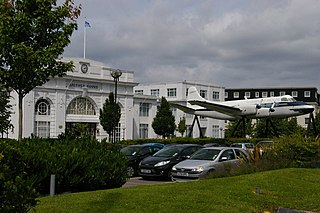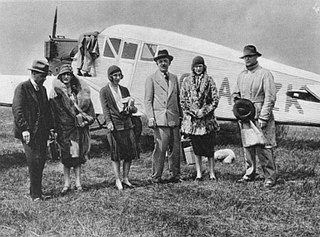
Imperial Airways was an early British commercial long-range airline, operating from 1924 to 1939 and principally serving the British Empire routes to South Africa, India, Australia and the Far East, including Malaya and Hong Kong. Passengers were typically businessmen or colonial administrators, and most flights carried about 20 passengers or fewer. Accidents were frequent: in the first six years, 32 people died in seven incidents. Imperial Airways never achieved the levels of technological innovation of its competitors and was merged into the British Overseas Airways Corporation (BOAC) in 1939. BOAC in turn merged with the British European Airways (BEA) in 1974 to form British Airways.

Croydon Airport was the UK's only international airport during the interwar period. It opened in 1920, located in Croydon, then part of Surrey. Built in a Neoclassical style, it was developed as Britain's main airport, handling more cargo, mail, and passengers than any other UK airport at the time. Innovations at the site included the world's first air traffic control and the first airport terminal. During World War II the airport was named RAF Croydon as its role changed to that of a fighter airfield during the Battle of Britain; and in 1943 RAF Transport Command was founded at the site, which used the airport to transport thousands of troops into and out of Europe.

The Vickers Vulcan was a British single-engine biplane airliner of the 1920s built by Vickers Limited at Brooklands Aerodrome, Surrey. It carried eight passengers and a pilot.

The Handley Page W.8, W.9 and W.10 were British two- and three-engine medium-range biplane airliners designed and built by Handley Page.

The de Havilland DH.34 was a single engined British biplane airliner built by the de Havilland Aircraft Company in the 1920s. 12 were built, with the DH.34 serving with Imperial Airways and its predecessors for several years.
Air Union was a French airline established on 1 January 1923, as the result of a merger between the airlines Compagnie des Messageries Aériennes and Compagnie des Grands Express Aériens. Air Union was merged with four other French airlines to become Air France on 7 October 1933.
Lympne Airport was a military and later civil airfield, at Lympne, Kent, United Kingdom, which operated from 1916 to 1984. During the First World War RFC Lympne was originally an acceptance point for aircraft being delivered to, and returning from, France but was later designated as a First Class Landing Ground, RAF Lympne. It became a civil airfield in 1919 and saw the operation of early air mail services after the 1918 armistice. It was one of the first four airfields in the United Kingdom with customs facilities.

On 6 January 1954 WJ474 a twin-engined Vickers Valetta training aircraft of No. 2 Air Navigation School Royal Air Force crashed near RAF Bovingdon just after takeoff in bad weather.

The August 1926 Air Union Blériot 155 crash happened on 18 August 1926 at Hurst, Kent when Blériot 155 F-AIEB of Air Union hit a barn and crashed whilst attempting to make a forced landing in bad weather. Two passengers were killed in the accident, and the pilot died a day later.
The 1947 Croydon Dakota accident occurred on 25 January 1947 when a Spencer Airways Douglas C-47A Skytrain (Dakota) failed to get airborne from Croydon Airport near London, and crashed into a parked and empty ČSA Douglas C-47 destroying both aircraft and killing 11 passengers and one crew member.

The 1957 Blackbushe Viking accident occurred on 1 May 1957 when an Eagle Aviation twin-engined Vickers VC.1 Viking 1B registered G-AJBO named "John Benbow" crashed into trees near Blackbushe Airport, located in Hampshire, England, on approach following a suspected engine failure on take-off. All five crew and 29 of the 30 passengers were killed. The aircraft also carried the RAF serial number XF629 allotted to this aircraft for use during trooping flights only.

The 1934 Hillman's Airways de Havilland Dragon Rapide crash occurred on 2 October 1934 when a de Havilland DH.89A Dragon Rapide of Hillman's Airways crashed into the English Channel off Folkestone, Kent, killing all seven people on board. The aircraft was operating an international scheduled passenger flight from Abridge Aerodrome to Le Bourget Airport, Paris. The accident resulted in the first write-off of a Dragon Rapide.

The 1929 Imperial Airways Handley Page W.10 crash happened on 17 June 1929 when Handley Page W.10 G-EBMT suffered an engine failure and subsequently ditched in the English Channel off Dungeness with the loss of seven lives. The aircraft was operating an international scheduled flight from Croydon to Le Bourget Airport, Paris, France.

The Meopham Air Disaster occurred on 21 July 1930 when a Junkers F.13ge flying from Le Touquet to Croydon with two crew and four passengers crashed near Meopham, Kent with the loss of all on board. The report of the inquiry into the accident was made public, the first time in the United Kingdom that an accident report was published.
The 1935 SABENA Savoia-Marchetti S.73 crash occurred on 10 December 1935 when Savoia-Marchetti S.73 OO-AGN of Belgian airline SABENA crashed at Tatsfield, Surrey, England, while on an international scheduled flight from Brussels Airport Haren, Belgium to Croydon Airport, United Kingdom. All eleven passengers and crew were killed.

The August 1923 Air Union Farman Goliath crash occurred on 27 August 1923 when a Farman F.60 Goliath of Air Union crashed at East Malling, Kent, United Kingdom following an engine failure and reported panic amongst the passengers. One person was killed and nine were injured, including celebrated French actor Jean Murat.

The 1923 Daimler Airway de Havilland DH.34 crash occurred on 14 September 1923 when a de Havilland DH.34 of Daimler Airway operating a scheduled domestic passenger flight from Croydon to Manchester crashed at Ivinghoe, Buckinghamshire, England, killing all five people on board.

The 1924 Imperial Airways de Havilland DH.34 crash occurred on 24 December 1924 when de Havilland DH.34 G-EBBX of Imperial Airways crashed at Purley, Surrey, United Kingdom killing all eight people on board. The aircraft was operating a scheduled international flight from Croydon, Surrey, to Paris, France. It was the first fatal accident suffered by Imperial Airways and led to the first public inquiry into a civil aviation accident in the United Kingdom. As a result of issues brought up during the inquiry, Croydon Airport was expanded, absorbing most of Beddington Aerodrome.
British Air Transport – The Pioneering Days 1919–1934 is an 8.44-metre (27.7 ft)-long mural by William Kempster depicting, from left to right, a chronological sequence of events in the history of British aviation on the London to Paris route starting on the left with Hounslow Heath Aerodrome in 1919 and finishing on the right at Croydon Aerodrome in 1931. The most recent aircraft shown is the Short L.17 Scylla of 1934.











